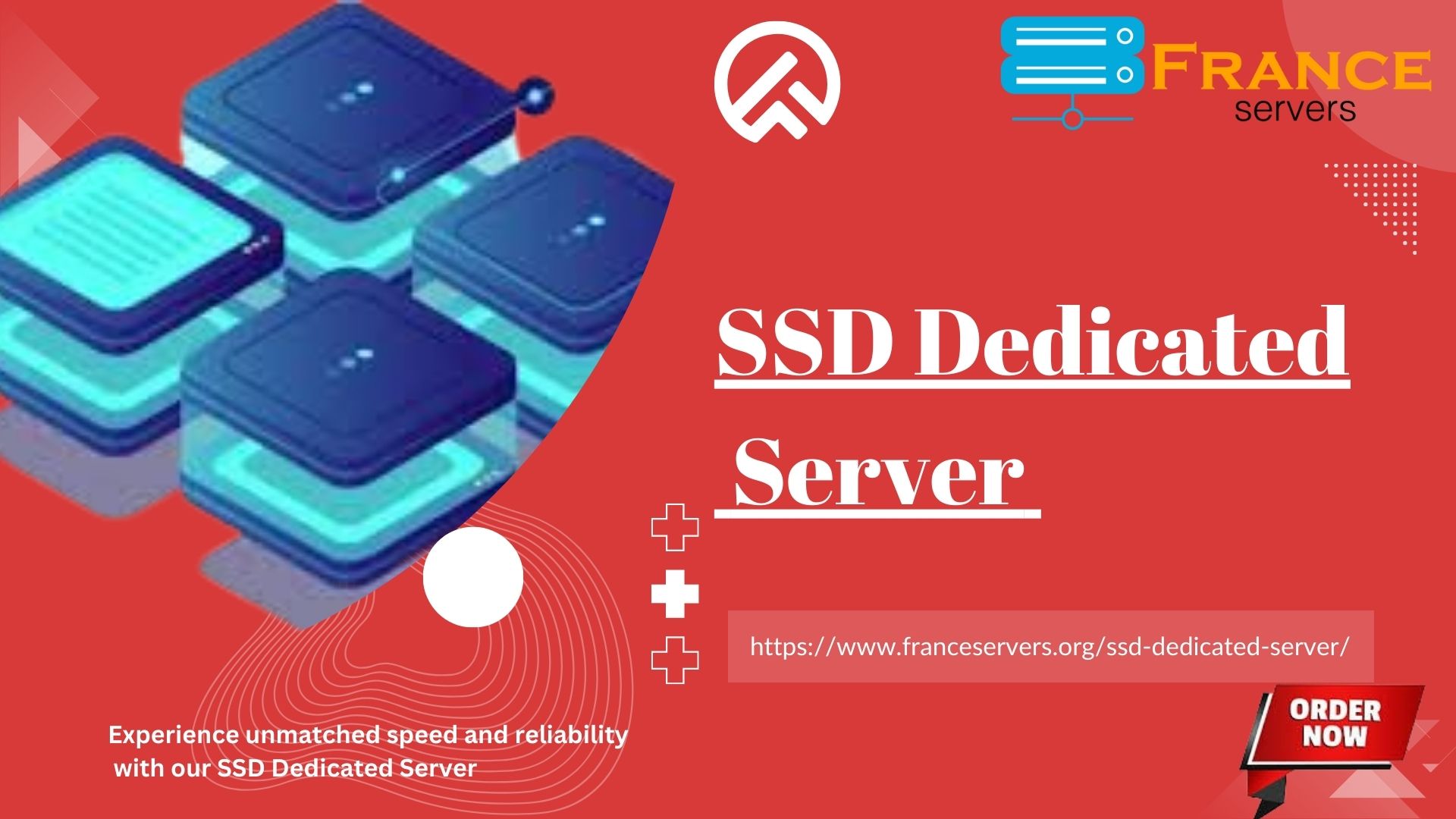Solid State Drives (SSD) have revolutionized storage in dedicated servers, France Servers offering faster speeds, reliability, and improved performance over their Hard Disk Drive (HDD) counterparts. Choosing the right SSD Dedicated Server specs is crucial in running your applications smoothly and effectively. This ultimate guide will provide insights and strategies to make the best choices for your needs.
the Importance of SSD in a Dedicated Server
Diving into the world of SSDs, it’s clear that they operate quite differently from traditional HDDs. They ditch the concept of spinning disks and reading/writing heads for a streamlined approach using flash memory. This subtle yet impactful shift results in a wave of benefits, notably speedier data access, superior durability, and enhanced system performance. These advantages become particularly crucial when integrated into a dedicated server. Imagine faster loading times for your website, providing a more seamless user experience. Envision being well-equipped to smoothly manage high-traffic situations without a hitch. Yes, all these can be your reality with SSD in your dedicated server. So, understanding and leveraging the power of SSD technology could be your secret weapon for unlocking unprecedented performance and user satisfaction.
Defining Your Server Requirements
It’s time to get to the heart of the matter – what are your server requirements? Think of this as the mission statement for your server. What tasks will it be performing? Perhaps it’s crunching large amounts of data, powering resource-intensive applications, or supporting a website with significant traffic. The answers to these questions provide the foundation for selecting the perfect SSD dedicated server. They help identify what kind of performance you need to fulfill your mission without a hitch. By defining your requirements, you’ll have a clear target, making the task of understanding and choosing technical specifications less daunting. So, before moving on to the nitty-gritty of server specs, take a moment to contemplate the fundamental role your server plays in your operation. Remember, understanding your needs is the first and most critical step in choosing the right SSD dedicated server.
Decoding the Technical Specifications
Navigating the labyrinth of server specifications can initially feel overwhelming. Nevertheless, there’s no need for panic. By focusing on four main components – the Central Processing Unit (CPU), Random Access Memory (RAM), storage, and bandwidth, you can make informed decisions. The CPU, commonly referred to as the server’s brain, carries out all computations, while RAM functions as a temporary data storage area, keeping data at hand for immediate processing. Storage, often the main highlight of an SSD-dedicated server, determines how much data the server can hold. Lastly, bandwidth – think of it as a highway that dictates the speed of data transfer to and from your server. We’ll delve deeper into each of these components in the following sections. But for now, take a deep breath and remember these four critical elements – CPU, RAM, storage, and bandwidth. As we decode the specifications together, it’ll become clearer how they work in unison to drive server performance.
Choosing the Right Processor and RAM
Consider the processor and RAM as the server’s control center and workspace, respectively. The processor, being the server’s control center, is responsible for executing all computations. Therefore, for tasks that require significant computational power, such as data-intensive applications, a multi-core processor is ideal.
Conversely, RAM acts as the server’s workspace, temporarily storing active data for quick access. Picture RAM as a desk. The larger the desk (RAM), the more documents (data) you can spread out and work on simultaneously. This enables the server to handle multiple tasks efficiently, thereby improving performance.
It’s essential to strike a balance between present requirements and future expansion when choosing these crucial components. Remember, what suffices today may not meet your needs tomorrow. Therefore, factor in potential growth and future requirements. This foresightedness can save you from unplanned upgrades or server switches down the line, offering you both cost and performance efficiency.
Choosing the right processor and RAM is like building the brain and workspace of your server. Make sure it’s well-equipped to manage your tasks today and scale up for tomorrow’s challenges.
Selecting the Optimum Storage and Bandwidth
Now let’s focus on your storage and bandwidth needs. With storage, the rule of thumb tends to be, the more, the merrier. Greater SSD storage capacity not only accommodates more data but also provides room for future growth and efficient application performance. On the other hand, bandwidth is the highway that controls data transfer speeds to and from your server. High-bandwidth servers can efficiently handle high-traffic situations, making them ideal for popular websites and busy applications. However, just like a busy highway, congestion can occur during peak times, slowing down data transfer. So, consider your data transfer needs in both normal and high-traffic situations to select the most suitable bandwidth. As you explore your storage and bandwidth options, remember to reflect on your server’s mission. Aligning your choices with your defined requirements will ensure you get the most bang for your buck while still maintaining top-notch performance. So, get ready to arm your SSD dedicated server with the storage capacity and bandwidth it needs to thrive in its tasks.
Balancing Performance and Cost
It’s easy to get swept up in the allure of top-tier specs but remember: gold-standard performance doesn’t always necessitate a platinum-level price tag. A high-end server might seem like a smart move, but could your operational needs be met just as effectively by a mid-range model? Top-spec servers carry hefty costs, and there’s no need to pay for the power you won’t use. Striking a harmony between performance and cost is the art of smart server selection. As you peruse your options, keep your defined server mission front and center. By aligning your selections with your actual requirements, you can secure an SSD dedicated server that delivers outstanding performance, without causing undue strain on your budget. So, when you’re weighing up the power and price of your server, remember: balance is key. Don’t let the shimmer of high specs blind you to the potential value and viability of less costly, but still highly capable, options.
The Importance of a Reliable Hosting Provider
Selecting the ideal SSD dedicated server specs is a significant task, but don’t overlook the value of a trustworthy hosting provider. Your hosting provider is the foundation of your server’s operation, offering the infrastructure and support to keep things running smoothly. Opt for a provider that has proven reliability, demonstrated through a high uptime guarantee. This assures you of their commitment to keeping your server online and functioning efficiently. Customer service is another vital factor; you want a provider who can promptly address and resolve any issues that may arise. Additionally, a provider that can offer scalable solutions will give you the flexibility to grow and adapt as your server requirements evolve. Remember, a great server is only as good as its hosting provider. So, invest time in choosing a provider that complements your server specs and aligns with your operational needs.
Conclusion
Choosing the right SSD dedicated server specs is not a task to be taken lightly. It’s a strategic process, requiring a thorough understanding of your server requirements and the technical specifications that align with these needs. By focusing on key components like the CPU, RAM, storage, and bandwidth, and balancing performance with cost, you’re equipped to make informed decisions that result in superior server performance. Factor in potential growth and future needs to save on unplanned upgrades or switches. Additionally, the role of a reliable hosting provider can’t be understated. A trusted provider serves as the backbone of your server’s operation, supporting its functionality and offering scalable solutions as your needs evolve.

